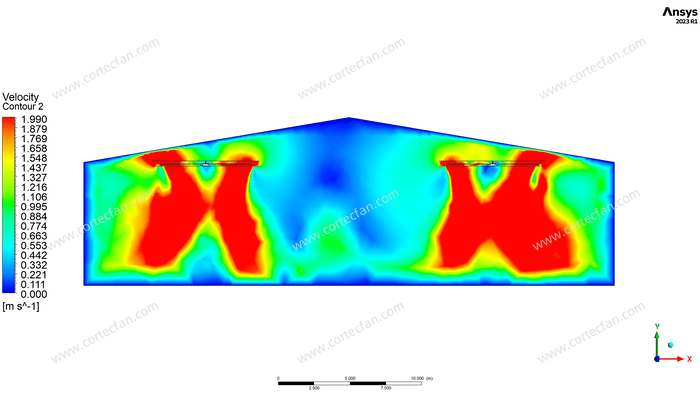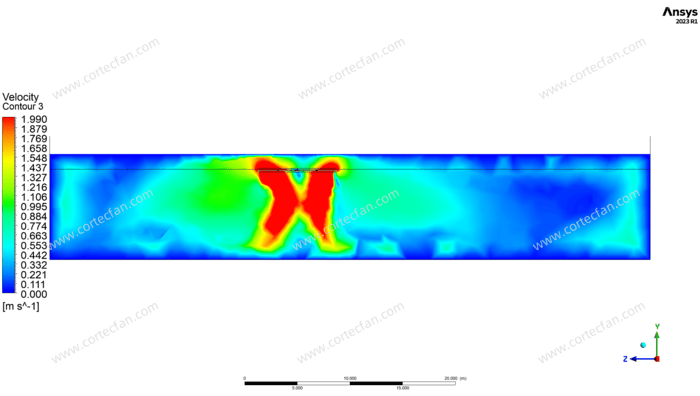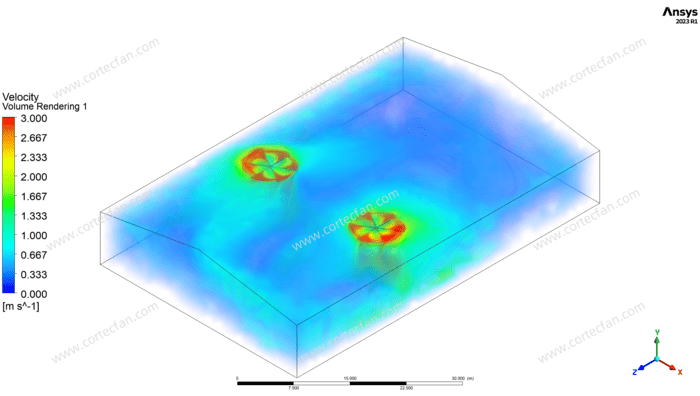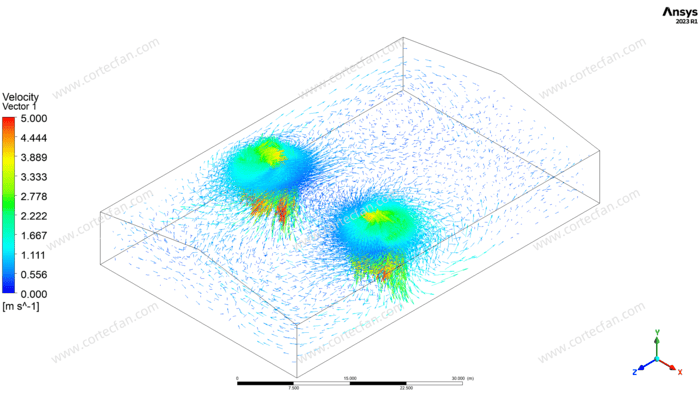Speed Contour
The study used computational fluid dynamics (CFD) technology to perform 3D modeling and simulation of the airflow field of a certain type of HVLS Fan, generating the following key results:
Contour 2: The maximum wind speed is 1.990 m/s, decreasing evenly along the radial direction to 0 m/s, showing a symmetrical distribution (Figure 1).

Contour 3: The maximum wind speed is 1.879 m/s. The gradient change is similar to that of Contour 2, but the wind speed in the central area is slightly lower, which may reflect the adjustment effect of different blade angles or installation heights (Figure 2).

Data characteristics: Both types of cloudehouses and logistics, and stadiums due to their low-speed and wide-range air delivery characteristics to achieve efficient and energy-saving air circulation and temperature balance. Based on multiple sets of numerical simulation data (Contour, Volume Rendering and Vector analysis) provided by Cortecfan, this paper analyzes the airflow distribution characteristics of HVLS Fans and their engineering application value.
Overview of numerical
maps show that the wind speed decreases from the core to the outer edge, which is in line with the design concept of HVLS Fans: "wide-area coverage and gentle air supply".
Volume Rendering

Volume Rendering 1 (Figure 3-4): Maximum wind speed is 3.000 m/s. The velocity stratification (3.000→0.000 m/s) clearly shows the three-dimensional diffusion pattern of airflow in three-dimensional space, verifying the fan's ability to mix air in vertical and horizontal directions.
Vector 1

Vector 1 (Figure 5): Maximum wind speed 5.000 m/s. The vector arrows intuitively display the direction and intensity of the airflow, indicating that the fan can locally increase the wind speed in a specific mode (such as directional air supply to high-temperature areas), taking into account flexibility and efficiency.
Airflow distribution characteristics and engineering significance
Low-speed wide-area coverage
All simulation results show that the wind speed range is concentrated in 0-5.000 m/s, which meets the low energy consumption and low noise operation requirements of HVLS Fans. In the Contour data, the maximum wind speed of 1.990 m/s can avoid the "blowing feeling" of traditional high-speed fans and improve the comfort of personnel
Dynamic regulation potential
The difference between Volume Rendering and Vector data (3.000 m/s vs. 5.000 m/s) shows that by adjusting the blade pitch or rotation speed, the "uniform air supply" and "directional enhancement" modes can be flexibly switched to meet the needs of different scenarios (such as cooling in summer and air mixing in winter).
Space optimization basis
Velocity gradient data (such as the 19-level stratification in Contour) provides a quantitative reference for fan layout. For example, in a space with a floor height of 8-10 meters, the equipment spacing can be designed based on the mid-level wind speed area of 0.553-1.106 m/s to ensure coverage without blind spots.
Application advantages and case analysis
Energy saving benefits
Taking Contour 2 data as an example, the wind speed range of 1.106-1.979 m/s can control the temperature difference of the space within 2-3°C while maintaining human comfort, saving 40-60% energy compared to the air-conditioning system.
Industrial scene adaptability
Vector 1s high wind speed mode (5.000 m/s) is ideal for local cooling needs, such as around foundries or production line equipment, to reduce hot spot temperatures and avoid energy waste from overall cooling.
Environmental friendliness
Low-speed operation reduces mechanical wear and tear. Combined with the durability material data provided by www.cortecfan.com, the fan life can reach more than 10 years, significantly reducing maintenance costs.
Conclusion and Outlook
Through multi-dimensional numerical simulation, this study systematically reveals the airflow distribution law and performance advantages of HVLS Fans, providing theoretical support for their scientific deployment in large spaces. In the future, we can further combine temperature and humidity coupling simulation to explore the comprehensive regulation potential of HVLS Fans under complex climate conditions. For technical details and case applications of Cortecfan series products, please refer to the official website (www.cortecfan.com) for more data support.



